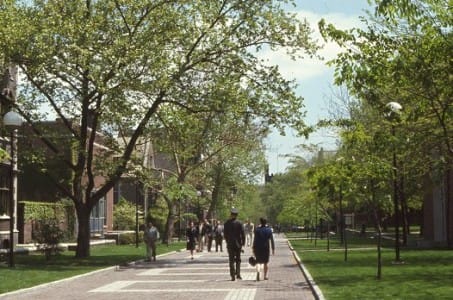I stared at my TV, spellbound, while Charlie Rose interviewed Penn President Amy Gutmann, HOM’04. Won over by her unequivocal endorsement of MOOCs—short for Massive Open Online Courses—I couldn’t wait to choose a suitable subject and sign myself on.
“We’re off and running,” she responded to Rose’s sober style. “It’s not a question of if they’ll work, but what will work.”

How Locust Walk might have appeared when the author first eagerly entered the Wharton world. Photo credit: University Archives Digital Image Collection.
Seated alongside Gutmann, The New York Times’ Tom Friedman offered support.
“MOOCs are an idea whose time has come,” he said. “Online classes can provide the best teachers from the best universities all over the world.”
When Gutmann explained that MOOCs held appeal for millions of students who aren’t positioned to have a campus-based experience—“students in far off Swaziland”—I felt she spoke directly to me. In terms of access to Steinberg Hall-Dietrich Hall, my Arizona home made a Penn on-campus experience about as convenient as it might be for a native Swazilander.
Gutmann’s interview with Charlie Rose took place this past April. Today, I look back on my first MOOC exposure not as a bad outcome, but as no outcome.
(Editor’s note: Watch the Charlie Rose roundtable about online education at about the 14th minute of the video below.)
http://www.hulu.com/watch/484371w=530
When I logged on to Coursera for the first time, I was filled with curiosity and energy. I’d registered for only one course, Franklin Allen’s “An Introduction to Corporate Finance.” The opening shot of the course’s first video panned Steinberg Hall-Dietrich Hall and welcomed me without reservation. I saw myself on Locust Walk eager to ascend the steps and enter the Wharton world just as I’d done 57 years ago in pursuit of an MBA.
Without delay, the course got down to business. It reviewed the four-point honor code: All work must be the student’s own except for assignments that permit collaboration. Otherwise, no sharing of exams, quizzes or homework.
Next, the syllabus laid out all the helpful details on the textbook, study advice, an exam, grading and problem sets. I sensed strong academic support and could hardly wait to begin.
Coursera then transported me via online video into the classroom of Wharton’s eminent Nippon Life Professor of Finance, and I am sorry to report, I soon felt like an outsider. The class was actually a pre-recorded lecture that Allen performed before a live Wharton MBA student audience. Although he was doing a superb job teaching, I never got the feeling he was teaching me. I saw myself as an observer, not as a beneficiary. While he established instant rapport with students inside his classroom, I longed to tell him I was one of thousands of eager students outside. Students and teacher seemed unaware that so many others depended on the clarity of their questions and answers. Queries directed to the professor were lost in transmission. Their answers to his questions were equally unintelligible. Perhaps it was the sound system that distanced me from their communication, but I believe it was something more fundamental.
With the sole purpose of making future MOOCs beneficial to all students, I urge professors to embrace their online students with this easy technique: Reiterate every in-class question and answer without exception. Thoughtful repetition will deliver an important message to all your online students: “I know you’re there, and I’m teaching you too.”
Better yet, professors might be better off not using their live classes for MOOCs; instead, they should record separate lectures that they teach with their online students in mind.
Incorporate these suggestions, and I’ll cheerfully return to “campus” again with the same eagerness I possessed 57 years ago.

























